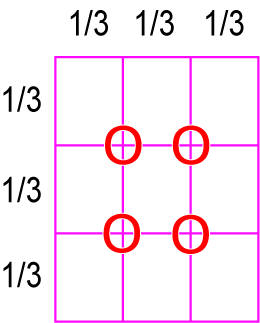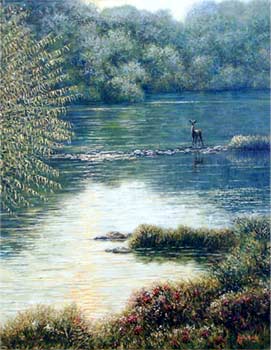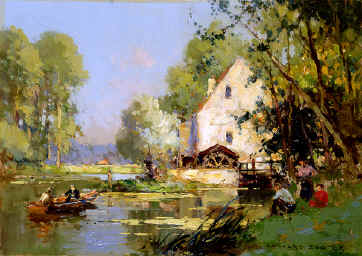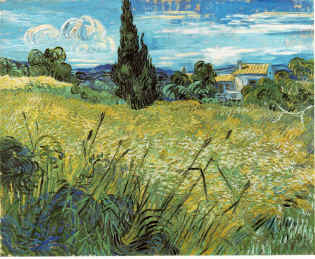

This composition works whether the painting has a vertical or horizontal format.
| HOME |
The Elements of Composition |
There are several types of compositions, but these are the most widely used:
The 1/3 x 1/3 Formula. Or the Classical Composition.
in this arrangement, we divide each side of the canvas by three equal
parts. Where the segments intersect are considered to be the optimum places
for the point of interest. The point of interest, the area of the painting
where the eyes are drawn to, should be placed in one of the four
positions. (market on the graphic with a red "O")
 |
 |
In the example, to illustrate the 1/3 x 1/3 composition, we
have used "Psalm 42:1" oil on Linen 16x20 Painted
by the Santa Maria Twins. When creating the composition for this
painting we decided to use the deer as the center of interest. That
means that the eyes should be led to the deer, which has been placed in
one of the four optimum places. The title of the painting is Ps.
41:2, which reads: " As the deer pants after the water brooks, so my soul
thirsts after you O Lord" With that in mind, we wanted the deer
to be the center of interest, and consequently it was placed in the right
upper optimum place. This composition works whether the painting has a vertical or horizontal format. |
![]()
The "Steelyard" Composition.
This type of composition uses the natural distribution of forms based on
size, starting with the larger size element, which should always be closer to
the center of the painting, and a smaller one which should be placed far from
the center in the opposite direction.
 |
|
| This graphic illustrates the "steelyard" composition |
In this beautiful painting by Claude Monet, we see this principle in action with the two haystacks. The larger one close to the center, and the smaller towards the viewer's left. This composition also uses the next principle of design. |
![]()
The 1/3 Horizon Composition
The idea is to avoid placing the horizon placed in the middle of the painting,
but instead to put it no more than 1/3 from the top, or 1/3 from the bottom of
the painting.
 |
Two beautiful examples of this popular composition. On the left: "By the Mill" by Edouard
Cortes. |
 |
![]()
The "Tunnel" Composition
This composition is strong and dramatic. All the elements if the
foreground are positioned in such a way as to lead the eyes of the viewer to the
background of the painting, where the focus of interest is. Many artists
have used this composition to give dramatic effect to their paintings.
|
|
|
| Camille Corot used the trees and the foliage to send the eyes of the viewer into the background, where the house has been placed as the center of interest. | Peter Paul Rubens shows us a dramatic rendering of "Daniel in the Lions Den" aided by the used of this powerful composition, where the lions have been positioned to point to Daniel. |
![]()
Note: These cannons of composition are meant to give you a starting point, and are not meant in any way to be unbending, limiting tools; but they serve the artist by providing tools to convey the intended message. There are many artists that challenged the conventional rules of composition and design as part of their style. So, don't let rules limit you but help you expand your potential.